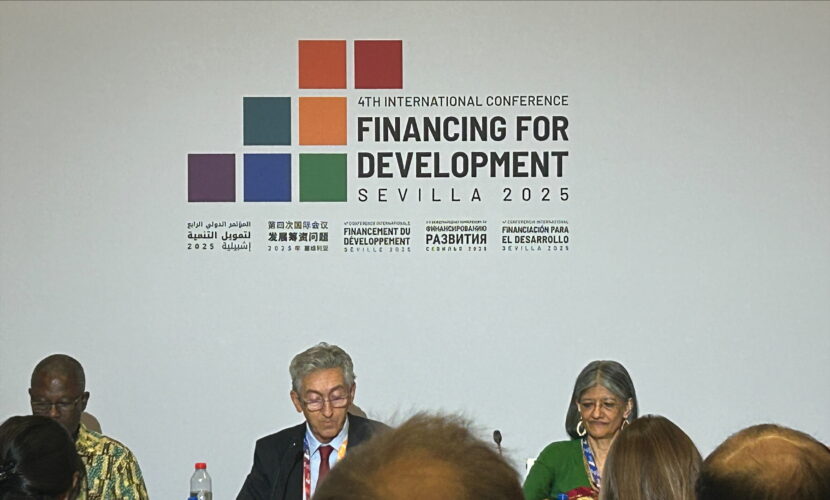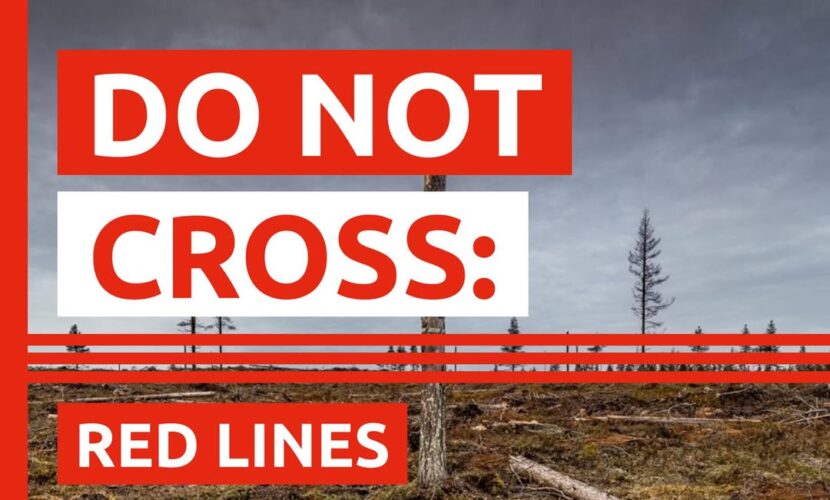Notícias
Incentivos financeiros para desacelerar o desmatamento são úteis – mas políticas públicas para pará-lo são essenciais

A reflection on the COP26 deforestation commitments in light of global policy efforts
By Jeff Conant and Merel van der Mark
Among the first announcements made at COP26 was a promise made by over 100 countries to halt and reverse global deforestation by 2030. The promise came with a nearly $20 billion commitment of public and private finance to help douse the flames of forest destruction.
UK Prime Minister Boris Johnson – not a fellow generally looked to for pearls of wisdom about ecological stewardship – called it a “landmark” commitment, saying, “We have to stop the devastating loss of our forests and end the role of humanity as nature’s conqueror, and instead become nature’s custodian.”
Without a doubt, more attention to deforestation is crucial and financing is desperately needed. When U.S. House Majority Leader Steny Hoyer followed President Biden’s announcement of the pledge by introducing a bill to create a $9 billion State Department trust fund for bilateral forest conservation efforts in tandem with developing nations, it was a well-timed and inspiring move – though it will only make a difference if the money goes to proforestation and legalizing land tenure for Indigenous Peoples and local communities who currently receive less than 1% of global climate finance.
Which is to say, there are reasons to be cautious, if not outright anxious, about the deforestation pledge made at COP26. As noted in nearly every news article about the announcement, this announcement comes on the heels of several failed commitments of a similar nature. In 2010 the Consumer Goods Forum (CGF), the world’s largest consortium of consumer brands and manufacturers, committed to achieve “zero net deforestation” by 2020 in soy, palm oil, paper & pulp/timber and beef supply chains – those most responsible for driving the crisis. Four years later at the UN Climate Summit in 2014, governments signed the New York Declaration on Forests (NYDF) which aimed to reduce deforestation by half by 2020 and end it by 2030 (notably, scaling back the CGF commitment by a decade).
But a five year assessment report put out in 2019 found that, “Instead of slowing down, tropical deforestation has continued at an unsustainable pace since the adoption of the NYDF. Since 2014, the world has lost an area of tree cover the size of the United Kingdom every year.” In fact, by 2019 global deforestation had increased by 43% since the New York Declaration.
This was followed in 2020 by the Consumer Goods Forum admitting it had failed to meet its target, and setting a new goal of 2030.
No wonder then, that some long-time watchdogs are calling the COP26 announcement, “just another in a long line of meaningless commitments.”
And then there’s the simple fact that that the $20 billion dollar figure tossed out at COP 26 is, by any measure, far from sufficient. The total cost of protecting and preserving the world’s rainforests has been projected by a number of studies with estimates ranging from $65 billion to over $500 billion USD per year. The UN State of Finance for Nature 2021 report assesses total investments needed to make forests a key pillar of limiting climate change at $203 billion a year; the New York Declaration on Forests itself estimated that financing needs for forest protection, restoration and improved forest management range from $45 billion to $460 billion a year.
Compare that to the $20 billion figure tossed out at COP26 – that’s $20 billion between now and 2030, or less than $2.5 billion a year – and you begin to see the set up for failure.
There is also real concern about the dangers posed by so-called Nature-Based Solutions, which, employed cynically, may aim to put forests to work as carbon sinks while neglecting to actually cut fossil fuel emissions and failing to put local and Indigenous land stewardship at the heart of the plans. This is why watchdogs like Friends of the Earth International call Nature-Based Solutions little more than a wolf in sheep’s clothing.
Indeed, with that wolf in mind, it should be lost on no one that the first global commitment to come out of Glasgow promised to throw buckets of money at the global forest fire, with no mention of phasing out fossil fuels and no real concern for human rights.
And what about private sector finance?
At the launch of COP26, Forests & Finance published a list of basic questions that any serious commitment to stop deforestation should have a good answer to. These questions center on the role of indigenous and local communities and the accountability of financial institutions.
The same day that President Biden, Boris Johnson and other world leaders committed to financing an end to forest destruction, more than 30 financial institutions, with a collective US $ 8.7 trillion in assets under management, committed to “to use best efforts to eliminate agricultural commodity driven deforestation from portfolios by 2025.”
Commitments by the investment community are refreshing, especially as the Consumer Goods Forum’s failure to halt deforestation by 2020 was underwritten by the world’s largest investors. During the last decade, the “big three” asset managers – BlackRock, State Street and Vanguard – increased their investments in the agribusiness companies directly responsible for widespread deforestation and doubled down on their failure by voting against or abstaining from every single shareholder resolution requiring companies to act on deforestation since 2012. So a commitment by investors to make their portfolios deforestation-free is a good thing – especially if it meets the basic criteria noted above.
Notable though, is that none of the large U.S. investment firms – neither the big three, nor other huge asset managers like TIAA, Fidelity, Northern Trust or Dimensional Fund Advisors, were willing to make such a commitment.
Some of these firms are, however, active in the Glasgow Financial Alliance for Net Zero, convened by former Bank of England Governor Mark Carney. The Network’s eye-catching COP26 claim that $130 trillion of private sector assets was committed to achieving net zero greenhouse gas emissions came with high-profile endorsements from BlackRock’s Larry Fink and CEO Jane Fraser of Citigroup.
Yet financial industry leaders have called the pledge “hot air,” and even such an insider news outlet as The Financial Times asked, “Does the maths on Mark Carney’s $130tn net zero pledge stack up?” – and, by way of answering the question, came up with a resounding no.
Of course it’s no surprise that the world’s largest financiers are still failing to get the maths right, because, to paraphrase the U.S. muckraker novelist Upton Sinclair, it’s hard to get a man to do something when his paycheck depends on not doing it. Since the Paris Agreement, financial institutions have provided at least USD 238 billion in credit to some of the largest forest-risk commodity companies in the world, which has netted them billions in interest, dividends and fees along the way.
Simply put, the financial industry continues to reap the rewards of forest destruction.
Which gets us to the crux of the matter: financial incentives to prevent deforestation could and should be an essential part of the solution. But disincentives for destruction are important too. While corporations and politicians are both eager to show their support for ending deforestation by pledging money and making rhetorical flourishes, neither seem willing to hold the world’s largest deforesters accountable through concrete regulatory and legislative efforts.
Only weeks before the spate of commitments at COP26, California Governor Gavin Newsom vetoed a bill that would have leveraged California’s enormous purchasing power to halt the destruction of tropical forests, by requiring the state’s purchasing to restrict contracts linked to rainforest destruction. After riding a wave of victory through both chambers of the state legislature, including a win of 30-8 in the senate, Governor Newsom vetoed the bill on the grounds that it might harm small business.
At the Federal level, while Representative Hoyer’s pending bill will allocate money to incentivize forest protection, it’s necessary complement would be a bill to disincentivize forest destruction. Fortunately, Senators Schatz and Blumenauer recently announced the Forest Act, potentially the first federal legislation to prohibit agricultural commodities produced on illegally deforested land from entering the U.S. market. The bill would require companies importing high-risk agricultural commodities and products to ensure that their supply chains do not contribute to illegal deforestation. While it only covers illegal deforestation – not insignificant as such, given that 94% of Brazil’s Amazon deforestation is illegal, while estimates for Indonesia hover around 80% – the Forest Act may face a stiff battle from Senate Republicans and their corporate backers.
A week after COP26 ended, the European Commission published a long-awaited proposal for a landmark anti-deforestation law, also meant to restrict products linked to deforestation from entering the EU. While it represents a watershed moment in the campaign to end Europe’s major role in destroying the world’s forests, the proposal still has some major shortcomings. For one, it does not apply to financial institutions. Furthermore, it relies on law enforcement in producer countries to determine if goods are linked to human rights violations – a profound concern in the world’s largest forest countries, like Brazil and Indonesia. As Human Rights Watch notes, the administration of President Jair Bolsonaro has dramatically weakened environmental law enforcement, effectively encouraging criminal networks that drive deforestation and that use threats and violence against forest defenders; similarly, Indonesia’s sweeping new “Omnibus Law” is widely perceived as a direct threat to both forests and human rights.
The new European Commission proposal also ignores non-forested biomes, which means that products linked to conversion of other natural ecosystems like Brazil’s Cerrado, will not be subject to this law. And, the proposal fails to cover key products, like processed meat and rubber, even though the supply chains of these products are often tainted with deforestation. A positive last-minute addition to the text is the recognition of the need for agreements with producer countries in order to facilitate compliance with the regulation. This can be an important lever to reduce the drivers of deforestation in producer countries.
In sum, politicians’ pledges and financial sector commitments to address deforestation made at COP26 lie on a spectrum from utter hogwash to dangerous distractions to far-too-little-far-too-late; legal regimes in most high forest-risk countries are being disregarded at best and dismantled at worst; and politicians in the hyper-consuming countries of the Global North continue to drag their feet and water down desperately needed laws.
In the wake of this latest global greenwash bonanza, this leaves civil society right where we were going into the COP – building aggressive campaigns to reign in corporate power, catalyzing efforts to win transformative legislation, putting human rights and social justice at the center of our demands, and making sure that Indigenous leadership is at the forefront of all of these efforts.
To read a concise analysis of the outcomes of COP26 itself in regards to land use, forests and human rights, see the Climate, Land, Rights and Ambition Alliance.








